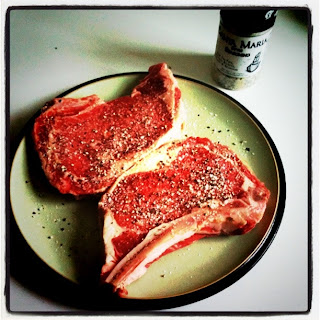Soo, this happened:
 |
| (I got a master's degree) |
It took up a lot of my valuable cooking and iPhone-photographing and blogging time, so, I apologize to my legions of readers (Coral). Sorry.
I also climbed this:
 |
| The columbia tower in Seattle, 1,311 steps |
That was a fun way to spend a Sunday morning...
Now that I've decompressed from the totally surreal experience of handing over a large chunk of one's brain, on paper, in triplicate, to a university to bind and put in a library, I needed to render some pork fat. Because that is what one does, no?
I've been thinking a lot about fat. I grew up hearing about how my various relatives ate nothing but lard-based pie crusts and bacon and eggs and lived to be 100 (followed by, "It's amazing that it makes us sick now! Please pass the margarine!"), and had kind of forgotten about it until little bits and pieces of information started to coalesce (like an arterial plaque!) - ok, hydrogenated fats are actually terrible for you, right... ew, vegetable oils are mostly re-purposed from industrial lubricants to foods post WWII? Well, I suppose that makes sense... um, AND the lipid hypothesis of heart disease is maybe completely unfounded?? I may need to re-think this can of spray oil...
Turns out animal fats are really, really delicious, and maybe less bad for you (even good for you?) than the late-20th-century may have led us to believe.
We've been saving and cooking with our leftover bacon and duck drippings, but I wanted to try getting a big lump of pig fat and making my own lard. Apparently buying the shelf stable stuff at the market is just as bad as margarine, since it's partially hydrogenated to improve its stability, or something. Just make your own.
There's lots of resources for how to do this on the web (
here is a good one, with lots of delicious fat photos), but basically you first want to locate some good quality fat from a healthy, well raised pig. The top quality is called "leaf lard," and comes from the interstitial fat of the animal and thus somehow has a more neutral flavor, or if you're not planning to use your lard for things like pastries you can just use plain ol' hog fat. That's what I did because it was what my butcher had on hand, so there.
Chop your fat into cubes. This is easiest to do if the fat is partially frozen (mine was VERY frozen, so I got really ugly pieces out of my hacking attempt, I was on a schedule). The method above says to remove excess meat and blood vessels, but I didn't do this since it was going to be a royal pain in the butt. This probably affects the final product in terms of flavor, but I think you can go either way.
 |
| looks like chopped chicken, but it's fatty fat fat! |
Then you put the fat cubes along with a 1/2 cup of water in a heavy saucepan or dutch oven, and place over medium-low heat. The fat will start to melt, and it will start to stink up your house something fierce, don't be alarmed. Stir the pot every 10 minutes or so to make sure nothing's sticking to the bottom, and cook until the bits of solids start to brown and sink to the bottom, they'll start making popping sounds when they're done, thus the term "cracklin's." (you can eat these, but mine didn't turn out super yummy... they may need additional cooking after you strain the lard off)
 |
| sizzlin' cracklin's |
|
Then strain the fat through a couple layers of cheesecloth in a fine mesh strainer into a container, like a mason jar, with a lid. Refrigerate and use as you like. I made some eggs for breakfast fried in the lard, and they were pretty darn delicious. Try it!
 |
| Chilled lard (L), drained cracklin's (R) |
 |
| My lardy egg breakfast, and cherry tomatoes! Must be spring! |
































